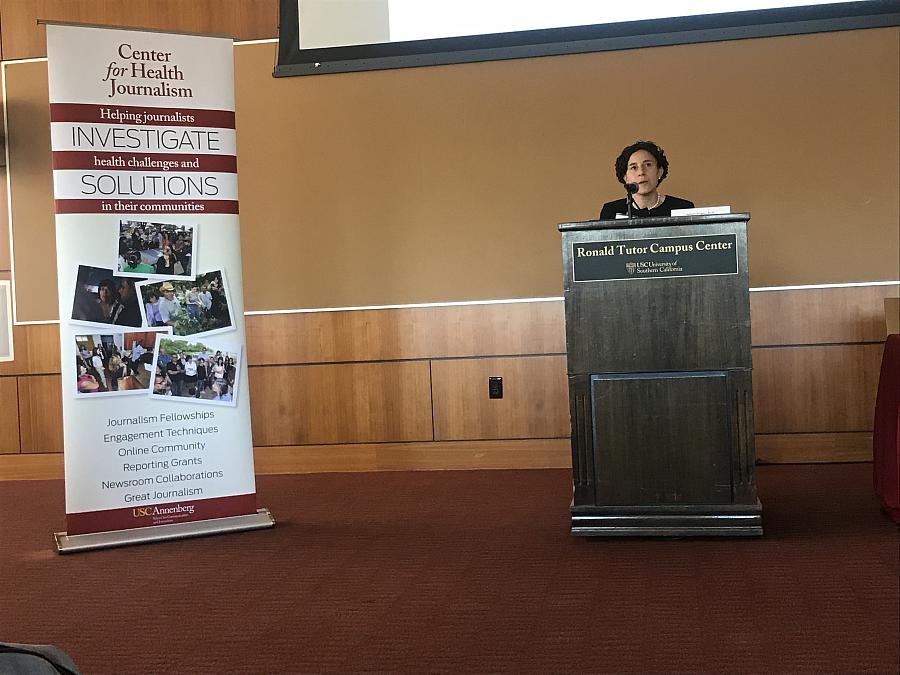Why the science of childhood trauma makes the news cycle so hard to watch

Natalie Slopen, an epidemiologist at the University of Maryland in College Park, talks to journalists at the 2018 National Fellowship this week.
Natalie Slopen is a Harvard-trained epidemiologist who studies how childhood experiences shape lifelong patterns of health. She’s part of a growing cadre of researchers that are asking, How does a child’s experience of severe stress get under the skin and lead, for instance, to drug abuse or depression or heart disease by middle age?
It’s an area of research given fresh resonance by the news cycle in recent weeks, as a steady stream of photos and news stories of young children separated from their parents at the border have gripped the nation’s attention. Slopen, an assistant professor at the University of Maryland in College Park, is particularly haunted by a Los Angeles Times video of a 6-year-old Guatemalan boy being reunited with his father after a separation of nearly two months.
As his father fights tears while walking toward him, the boy’s lack of emotion is uncanny: He doesn’t smile nor lift his arms as his father wraps him in his arms. Instead he stares blankly, arms limp, before being awkwardly carried off by dad. “He’s not receiving any comfort at all from an interaction that he should,” Slopen told reporters at the 2018 National Fellowship this week. The boy’s father knows something is wrong, telling the Times’ reporter, “This is not how I gave them my son. My son has come back to me sick.”
Slopen, deeply versed in what the sudden loss of a protective parent does to the body’s stress system, is worried about the long-term consequences these separated kids will suffer. “We are witnessing children being traumatized right now on a daily basis in the news,” she said. “These kids at such a young age are desperate for someone to comfort them, and that’s not happening.”
Parents play the central role in buffering stressful events for young children. When they’re not around or incapable of playing that soothing role, a child’s stress-response system can become stuck in a constant state of high alert, triggering chronic inflammation, developmental delays, and eventually, chronic diseases. Inflammation may be one of the key links connecting trauma and stress to health problems — the connection has been bolstered by a growing body of research in recent years. Slopen said that when she worked on a review of research on the link in 2012, there were 20 studies. “That number has probably quadrupled by now,” she said.
But these problems of unrelenting stress and trauma aren’t just a question of parenting. They’re impacted by larger forces in the community level as well. Slopen points to a study published last year by Tulane’s Katherine Theall and colleagues that looked at how children’s responses to stress might be linked to rates of violent crime, domestic violence, and proximity of homes to liquor and convenience stores in New Orleans. “The kids who had highest levels of these risk exposures had these blunted cortisol patterns, where they’re consistently lower than the kids with low levels of these risk exposures,” Slopen said. “They’re not responding the stress test the way one should.”
The study found the same pattern held true for the children’s telomeres, which are often used as a measure of biological aging at the cellular level. The kids exposed to higher levels of crimes, violence and liquor stores had shorter telomeres than their peers.
This growing body of research can easily seem depressing, with inescapable misfortunes and toxic environments reprogramming young minds and bodies, potentially for life. But Slopen and her colleagues, such as Harvard’s Jack Shonkoff, don’t subscribe to that sort of fatalism. They point out that there are known interventions that can lessen or reverse the effects of trauma and toxic stress, and that children are incredibly resilient when given the right supports.
Slopen cites a number of studies have shown there are programs and interventions that can bring cortisol patterns back to normal in kids. “It may be possible to repair stress regulatory systems after childhood trauma or other types of adversity,” she said.
She also points to research led by Gene Brody at the University of Georgia’s Center for Family Research. The Strong African American Families (SAAF) developed there targets low-income black families living in rural Georgia with a seven-week long program, designed to improve parenting skills. Eight years after the families completed the program, researchers were still finding lower levels of inflammation among kids in the treatment group.
While the research on childhood adversity and health is a burgeoning field with far-reaching consequences, broader public awareness and policy movement still lag behind. There’s a big opening here for journalists and the power of storytelling, Slopen says.
“What we need is people who can tell these stories in ways that resonate with the public and bring together all these pieces of evidence … from the literature on childhood diversity — to be able to tell it in a way that’s convincing.”
**

